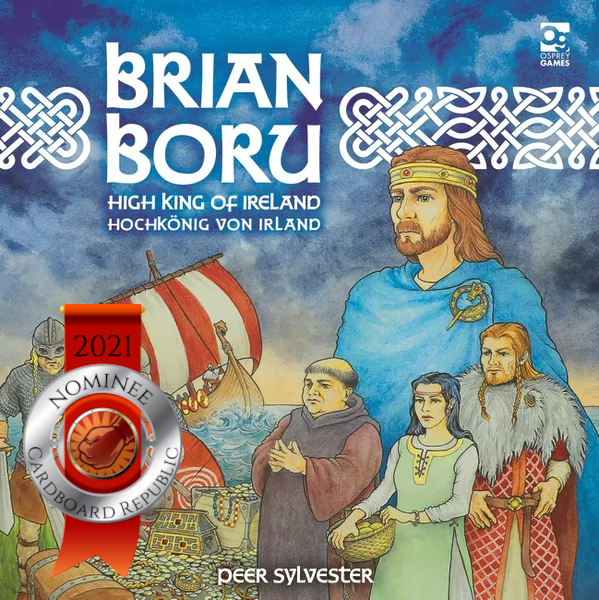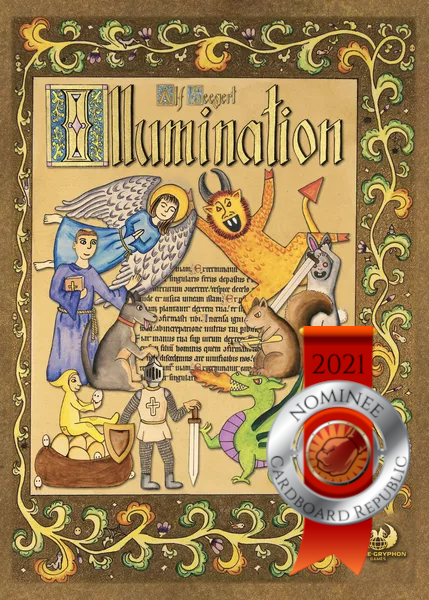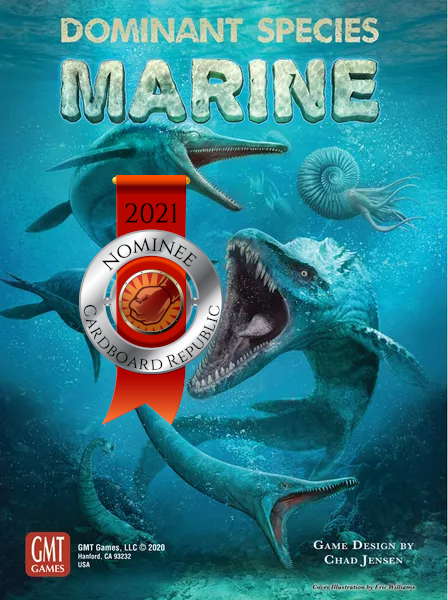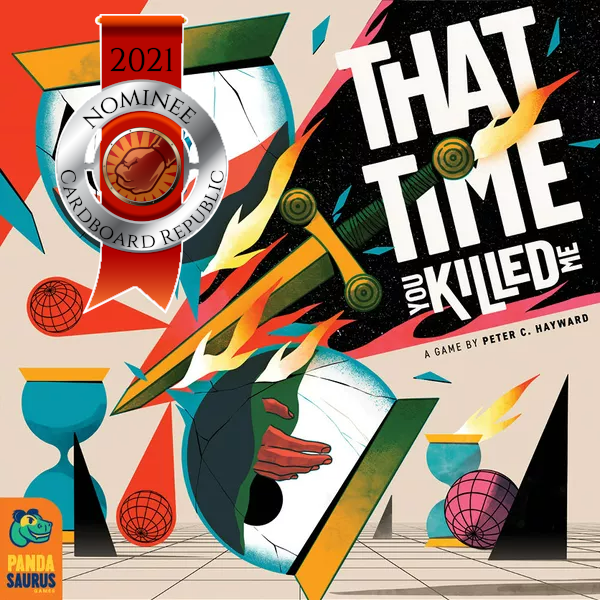The Cardboard Republic has rolled out the annual Laurels of the Republic awards, celebrating the best new games released in 2021 for each of the gamer archetypes. What follows are the finalists for one of those groups.
 Always looking for the next conflict, Strikers are those who prefer to make bold, declarative statements in their games. Their ambitions are simple: win by any means necessary, and do it quickly if possible. Strikers thrive in games where there are clear goals and the player’s chances of a particular strategy isn’t going to completely fall apart due to high degrees of luck or overly-lengthy affairs where their opponents will have ample opportunities to stop them. In short, the best Striker games are those where they are given a pointy stick and told in which direction to swing it.
Always looking for the next conflict, Strikers are those who prefer to make bold, declarative statements in their games. Their ambitions are simple: win by any means necessary, and do it quickly if possible. Strikers thrive in games where there are clear goals and the player’s chances of a particular strategy isn’t going to completely fall apart due to high degrees of luck or overly-lengthy affairs where their opponents will have ample opportunities to stop them. In short, the best Striker games are those where they are given a pointy stick and told in which direction to swing it.
And with that, here are The 2021 Laurel Finalists for Strikers:
Honorable Mention: Ruination
Publisher: Kolossal Games | Players: 2-4 | Play Time: 60-120 Minutes
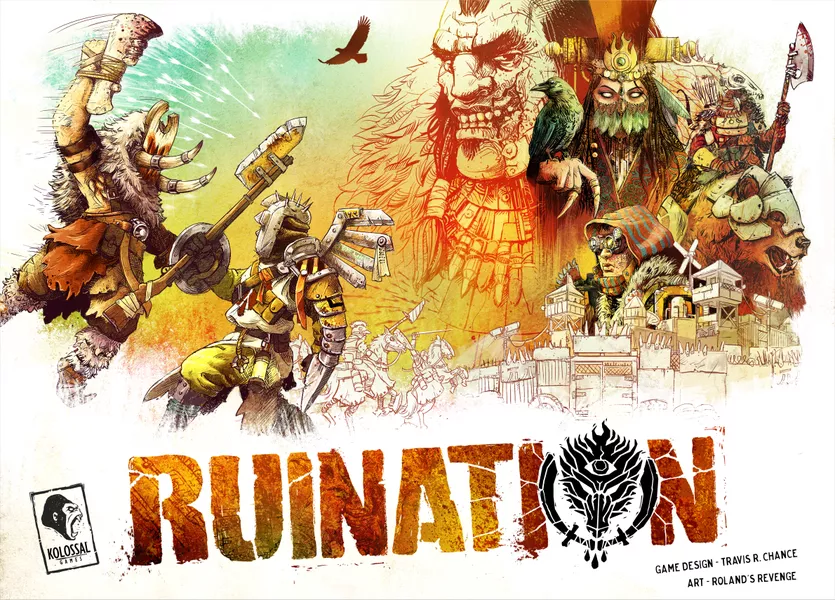
We’ll be the first to admit that we struggled a bit on this one, and it wasn’t for lack of effort. It wasn’t because there was a shortage of worthwhile games of 2021 that play to this group’s strengths: player-driven game outcomes, straightforward objective-based goals, and a focus on agency over the capricious whims of luck-driven events. Quite the opposite, in fact. 2021 had quite a few to choose from, and we agonized over which of the semi-finalists should get this slot of mention quite literally until the end of the process. In the end, by a hair, we opted for the oft-overlooked Ruination by Kolossal Games.
At first glance, Ruination seems like just another Dudes On A Map game, and from a high level vantage it’s hard to argue with that assessment, especially given the game’s modest Kickstarter presence. We get it. It’s an increasingly crowded genre that continually amps up demands for more. More plastic. More flash. More dudes on a bigger map. It’s an irresistible and increasingly insatiable feedback loop, especially on a vehicle like Kickstarter that has fomented so much of the genre’s hype and success that seemingly anything less than a seven figure goal must mean it’s lacking somehow. It’s no wonder that the far more grounded Ruination struggled across the finish line.
But that more grounded presentation also kind of fits the intentions of the game. Just perhaps in a slightly too meta way.
Because while Ruination has the same ultimate purpose as its brethren – expand your dominion across a post-apocalyptic terrain and deal with anyone standing against you – it’s also not intended to be grandiose. In Ruination the world is long past fallen, resulting in a grainy, continuous down-to-earth style grind that’s more circumscribed and less cinematic Marvel climax. Here, your handful of basic actions each round are boosted by corresponding card bonuses, allowing you to tailor and optimize your efforts in the moment, which in turn may gain you additional combat-centric effects. All for your singular goal of gaining and holding territory. Player-driven choices power most of this endeavor, as is often the case with the area control genre, and Strikers will feel right at home trying to become the new lord of the Eurasian steppes.
Ruination fits right at home amongst its family, even evoking partial motes of similar titles to have appeared on this list in the past such as Inis, Blood Rage, or Kolossal’s own Mezo. But its own unique identity and experience is what truly draws this group in – an enticing contest full of intentions and incentives. It’s restrained but compelling. Straightforward but dynamic. And where victory favors the bold.
The Nominees

Number Five: Brian Boru: High King of Ireland
Publisher: Osprey Games | Players: 3-5 | Play Time: 60-90 Minutes
Every game mechanic brings with it an intrinsic quality that lends itself to specific styles of gameplay. Simply put, while none exist are iron-clad, there is some correlation between specific mechanics and the kinds of games people enjoy playing.
One of the rare outliers to this understanding, however, is trick-taking. Maybe it’s because they’re socially-focused card games with a profusion of strategic subtleties which cut against social game expectations. Maybe it’s a byproduct of being over 500 years old. It’s hard to say. But few mechanics garner such a bifurcated level of interest. For most, either you love trick-taking games, or you don’t.
This game upends those presumed interests by cleverly integrating it into a larger fight.
Brian Boru centers around the millennia old exploits of an Irish king who used his prowess with the blade and prowess with his court to unite the Emerald Isle, fend off Viking invaders, and secure domestic loyalty through strategic alliances and political marriages. Your typical 11th century over-achiever.
In a canny twist, however, rather than convey this area control manipulation through endless dice battles or fistfuls of plastic, it’s through trick-taking. Thanks to Peer Sylvester’s deft handiwork, this seamless hybridization of mechanics masterfully encapsulates the best of both: direct control over your path to victory while retaining the nuanced allure of calculated card plays.
Brian’s tale is re-enacted over 3-4 rounds. In each of them, players draft a hand of cards of varying colors and numerical values. Then those hands are played one turn at a time, with the lead player selecting one of the island’s available towns and playing a card of matching. Everyone else may play any card; you do not have to follow suit.
In fact, part of the ingenuousness with this game is that depending on your goals, you may prefer to lose. The winner of the trick may claim the town, but losing players get consolatory actions on their cards instead, such as fighting Viking raiders or ingratiating yourself with the church. Controlling territory is valuable, but every sphere of influence aids you in the long run, thereby granting players not just multiple scoring avenues but the ability to competitively course correct as the game unfolds.
Above all, despite being entirely card driven, Brian finds appeal with Strikers because players have a surprising degree of control over their kingdom’s destiny. You have outsized say over which cards to draft, which towns to contest, and where best to spend your limited actions. Brian Boru effortlessly blends straightforward, familiar mechanics with direct and meaningful turn outcomes in a way that this group thrives on. It’s a pretty tricky thing to do. Brian Boru just makes it look easy.
Number Four: Illumination
Publisher: Eagle-Gryphon Games | Players: 2 | Play Time: 45-60 Minutes
There is no surefire formula to the provenance of a remarkable game. While it would be easy to evaluate a game’s worth based on universal metrics such as the number of people who have played it or its overall commercial success, it’s not that simple. Value and success, aside from being relative and subjective, are not mutually exclusive. Sometimes middling games are wildly popular, and sometimes a highly commendable title gets overlooked for myriad reasons.
The tile-laying and area scoring game Illumination is a pristine example of this, arriving by way of a very modest Kickstarter despite it coming from an established publisher (EGG) and the esteemed mind of designer Alf Seegert. As a result, Illumination likely isn’t just the least well-known title on this list but likely of all this year’s Laurel nominees. Yet that doesn’t dilute its merit. With past titles including The Road to Canterbury, Fantastiqa, and Haven, Seegert has demonstrably proven his knack for interesting and engaging two-player gameplay. Illumination is the latest in that acumen.
Illumination puts your ecclesiastical skills to the test in a figurative battle between two rival medieval monks trying to become the new head of the local Scriptorium. This high-minded contest of influence plays out (abstractly) by creating illuminated religious manuscripts. In a series of alternating turns, each monk places a row or column of randomized artwork tiles form their board onto one of the 3 corresponding manuscripts being contested. One of you insists on adding solemn and reverent symbols of loyalty and pious devotion to the margins, including angels, knights, dogs, and naturally, monks. The other monk, due to too much solitude or too much of the local brew, instead presents a much more whimsical vantage in opposition, placing demons, dragons, squirrels…and murderous rabbits.
(Fun fact: manuscript depictions of violent Leporidae were totally a real thing and not just conjured up by Monty Python.)
Placing tiles can earn coins, opening up strategic opportunities for tile manipulation or gaining special effect cards and/or ritual tokens, to be turned in to curry favor with the Abbot. Most importantly, if ever a group of opposing tiles be surrounded those figures clash, with the numerically superior side winning that icon-o-clash. When every book is complete, the combination of these conflict wins and ritual donations largely determine which monk’s grand artistic vision wins out.
As with many great abstract-style games Illumination provides depth of choice without being overly or unnecessarily complex. Despite its own genesis, with a successful but unconventional theme, a free form turn structure, and ample room for tactical maneuvering towards a straightforward purpose, it doesn’t take divine intervention to see why Illumination’s appeal in general, and this group particularly, is bright indeed.
Number Three: Dominant Species: Marine
Publisher: GMT Games | Players: 2-4 | Play Time: 90-150 Minutes
Whether for its innovation, popularity, or critical success, tabletop gaming has its share of notable games so praised (or pilloried) to become widely known points of reference.
In 2010, one such title to come along was Chad Jensen’s expansive area control game Dominant Species. Even if you’ve never played it before, there’s a chance you’ve heard mention of its two signature traits: it is long and it is mean. Which is true. DS thrives at higher player counts for optimal interaction and requires extensive planning not just for the intended sequence of your worker placement fueled turns but for contingency moves. As a competition for limited territory and resources, it can also be brutish and unforgiving due to your own miscues or the machinations of your opponents.
Or both. It’s often both.
Dominant Species was a surprise hit. A game that prefers 5-6 players, takes 3-4 hours, and operates by interweaving extensive heavy Euro style planning alongside territory control which can be ephemeral under the best conditions? Yet it struck a chord with audiences willing to embrace both.
Dominant Species: Marine is the evolution of this model…which slightly ironic given its period of interspecies conflict predates the original by a few epochs. Yet the most intriguing part to DS:M is that we’re talking about it here. Because while it bears much of the same DNA of its predecessor, Marine is not a retheme or new edition. Both its scope of gameplay and, by extension, its audience, have been reworked, creating a game with a markedly different feel. Hence its (rightful) eligibility.
DS:M, similar to its parent, revolves around placing or retrieving workers. Spaces present a range of actions allowing you to explore new territory, gain food, increase your population, score points, and clash with enemies, all while contending with changing terrain and a series of events that are now more unpredictable. Repeat until the asteroid shows up.
Where Marine diverges, particularly enough to catch the attention of Strikers, is that the entire enterprise is rebalanced to reward tactical prowess as much as extensive forethought. Actions are now more transactional, resolved immediately rather than as part of a well executed string, and special workers can get around blocked spaces, ensuring your ambitions aren’t so easily derailed. Planning is still necessary to achieve your desired objectives, but getting there is a faster process now. One less prone to being completely scuttled from some master counterstroke. One easier to adapt to while supplying the means to control your own agenda.
An agenda which, naturally, is to dominate the competition.
Number Two: That Time You Killed Me
Publisher: Pandasaurus Games | Players: 2 | Play Time: 20-40 Minutes
If there’s one thing two years of pandemic life has taught everyone it’s that time is less rigid than we originally thought. In a small way, that fact is perfectly encapsulated in the well-justified praise for the eclectic time-travel game That Time You Killed Me. Because even during its release in the distant past that was autumn 2021, we paradoxically were aware our future selves would be talking about it today. Which is us. And now.
Which raises the question about whether the now-us decided to bring forth our laudable appreciation for this wonky and quick-witted tactical jaunt because we felt it was warranted or whether we were always bound to do so thanks to the actions of past-us having knowledge about what the future-us was going to do. Or is it a matter of…
…you know what, let’s not think about the details of it too much. One way or another our focus brought us to That Time You Killed Me. And rightfully so.
In this two-player battle of wits, one of you has invented time travel. The other has decided to go back in time and kill them so they can invent time travel instead. Which means you need to kill them first by erasing them from multiple timelines. Ergo a temporal dance of death. Because that’s how this stuff works.
Thematically much of TTYKM operates like Weird Al went for a joyride in the TARDIS and rewrote the rules to 3-D Chess. Yet its core gameplay is a cerebral tête-à-tête fueled by player-driven reactions to a fluid board state. Both sides have a handful of character pawns spread across three identical boards representing past, present, and future timelines. Though a series of alternating turns you take actions which involve moving around the boards and / or jumping between timelines with the intent of shoving opposing pawns into walls or into duplicates of themselves to kill them off. Completely remove their presence from 2/3 timelines and that flux capacitor patent is all yours.
TTYKM’s worth is further boosted through a minor narrative campaign via a series of modules, each of which inject a slate of additional rules, abilities, and even more wry humor. The result being a game with abundant variety and replayability without sacrificing otherwise streamlined gameplay. To capably pull this off, careful timing, maneuvering, and spatial processing aren’t just encouraged: they are essential.
Though much attention (and adulation) focuses on the game’s flavor or visual elements, that almost obfuscates how substantial That Time You Killed Me is as a taught and snappy, low-luck tactical game. This is a Striker’s game through and through – in any timeline.
In another timeline, it may have even gotten the top slot, if not for another title with a similar life or death ultimatum…
The Winner
2021 Striker Laurel – Radlands
Publisher: Roxley Games | Players: 2 | Play Time: 20-40 Minutes
The moment we first tried the card game Radlands we had a hunch we may be revisiting this plucky title again down the dusty and dilapidated road. Sure enough, despite an extensive excursion through many objective-focused 2021 titles, here we are. But with a fully justifiable reason: Radlands does what it means to do with a hard to match electric, frenzied poise.
Last year certainly had no shortage of titles within the wheelhouse of goal-oriented Strikers, from miniatures-laden fighting games to the annual handful that feel like a Magic: the Gathering spinoff. Two were about legal trials. Two! But when it came to purity of purpose with an engaging engine and player-driven calculus, Radlands was hard to top.
Radlands, the latest addition to the robust punk-apoc genre, combines the vibrant and absurdist attitude of Tank Girl with the grim and gritty determination of Mad Max. In this speedy and flavorful head-to-head clash full of small arms weaponry and questionable fashion choices, two players attempt to annihilate their opponent’s base for access to one specifically scarce item: water. Through a series of quick alternating turns, both sides race to destroy their opponent’s three camp cards before they do the same to you. Camps, like the larger shared pool of cards in the game, are ample in quantity and vary extensively in their abilities. The result is a surprising degree of game-to-game variation brimming with subtle yet meaningful strategic considerations.
Aiding you in these efforts are a hand of cards representing your available clan folk. Leaning into the game’s compelling mix of brevity and tactical depth, its crisp, eye-popping multi-use People cards can be discarded for effects or recruited into your territory.
People in your territory serve a dual purpose as fodder…er…defenders of your Camps and sources of useful activated abilities – most of which involve lobbing some form of damage across the table. Since everything only has 1-2 health, upkeep is minimal and damage semi free-form in delivery, keeping the game moving at a brisk pace.
Constricting all your choices is water, the game’s only resource. With just 3 water per turn, Radlands’ restricted economy is as brilliant as it is maddening. Decisions must be methodical and calculating, and while luck plays a small role, it’s the combination of tactical maneuvering and card synergy that’s paramount to victory in this hellscape.
It’s almost like indecision in an apocalypse will get you killed.
With spirited gameplay, extensive replayability, and a swift pacing full of player-driven choices – all quite literally gunning at a sole objective – Radlands is precisely the sort of scenario this group takes to like, well, water. Hence why it has handily earned this group’s top spot of 2021.
![]()
Radlands Contest!
When it came to figuring out how we wanted to show off this year’s Striker Laurel we initially thought it would be ideal to really go all out and have (an albeit non-lethal) Road Warrior style race across the desert, complete with modified vehicles and a host of unexpected obstacles along the way. However, we ended up scrapping the idea. The powers that be will say it’s because it’s wayyy too risky and call it a lawsuit waiting to happen. WE say we abandoned it because we’re no where near the Australian outback and we insisted on authenticity, dang it! So then we attempted to pivot into just doing some kind of post-apocalyptic style fashion contest. A couple of us even ended up proactively getting the mohawks ready. (Claudius looks spectacular.) Unfortunately that too fell apart due supply chain issues getting enough worn leather scraps. So in the end we scaled our ambitions back and instead opted for the most direct approach: providing one lucky winner with the opportunity to enjoy the award-winning game first hand. That is what we’re going to to do right…now.
That’s right! Enter below for your chance at your very own copy of Radlands!
Note: In honor of their award recognition, Roxley Games has kindly provided a copy of this game for giveaway purposes.
![]()
Be sure to check out the 2021 Laurel Award pages for the other archetypes once they go live!

